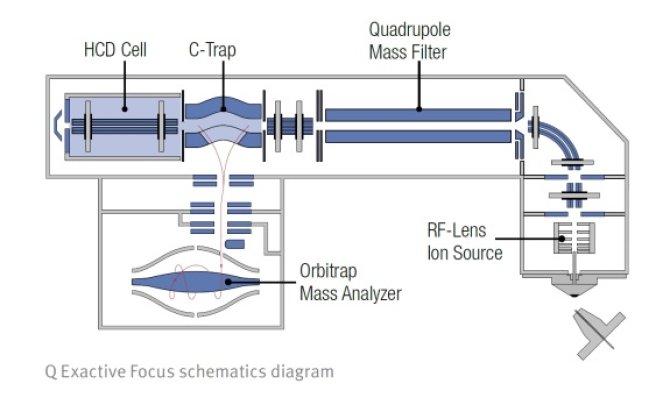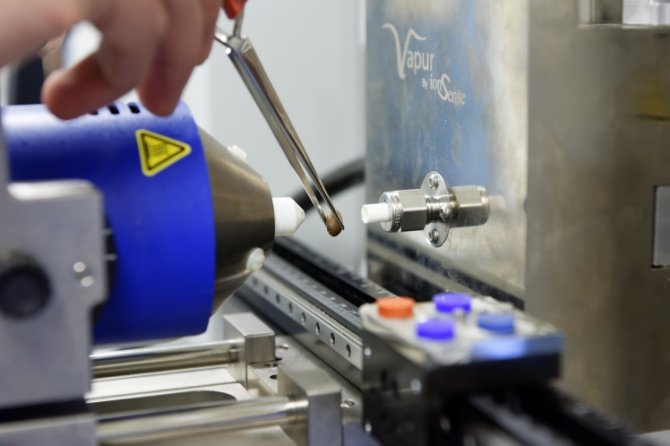
Product
Q-Exactive Focus - DART
Q Exactive Focus mass spectrometry with DART (Direct Analysis in Real Time) produces mass spectra in real time, directly under ambient conditions without sample treatment, without solvent extraction or other sample preparation, even directly on surfaces as paper, glass, TLC plates. DART is a non-contact sampling method. In contrary to traditional solvent sample introduction, almost no memory effect between different samples occurs. DART offers convenience of sample analysis and overcomes restrictions in speed, as experienced in mass spectrometry analysis with traditional available ion sources.
When using DART coupled to a high resolution MS (HRMS) such as the Q-Exactive-Focus, time consuming separation techniques as HPLC are not required.
The DART is also able to analyse less polar compounds with the traditional ESI source, but within a lower mass range. The default mass range is below m/z 1200 (due to the heating with the DART), but higher masses of thermal stable compounds can be analyzed.
In contrast to DART, other mass spectrometry analysis methods with high vacuum system require time consuming sample preparation. Then the dissolved samples may result in carry over between samples. Furthermore, solid samples can analysed with a direct insertion probe with according drawbacks.
Technical details
The Q-Exactive Focus mass spectrometer DART combines quadrupole precursor selection with high-resolution, accurate-mass detection, with a sensitivity that rivals triple quadrupole mass spectrometers and a resolution that surpasses Q-TOF instruments.
- Exceptional sensitivity thanks to superior selectivity that eliminates interferences allowing lower limits of detection and quantitation
- Fast polarity switching, so more classes of compounds can be processed in a single analysis
- Resolution superior to Q-TOF instruments for more confident identification and confirmation
- Exceptionally wide linear dynamic range
- Installed with a DART probe is a new ionization device for rapid, non-contact surface sampling of compounds.
More Technical Details
- Gasflow: Helium or Nitrogen
- Temperature range: 50-550 °C
- Sample introduction manually or automatic with different sample modules
| Resolving power | 70.000 (FWHM) at m/z200 |
| Mass Range | 50 to 2000 m/z |
| Scan rate | Up to 12 Hz at resolution setting of 17.500@m/z200 |
| Mass Accuracy | internal<1ppm RMS, external<3ppm RMS |
| Sensitivity Full MS | 500 fg buspirone on column S/N 100:1 |
| Sensitivity SIM | 50 fg buspirone on column S/N 100:1 |
| Dynamic range | >5000:1 |
| Linear Dynamic range | >1.000.000 |
| Polarity switching | One full cycle in <1sec (one full positive mode scan and one full negative mode scan at a resolution setting of 35.000) |
| HCD collision cell | Fragmentation with high-resolution accurate-mass detection |
Principles
Principle Q-Exactive-Focus

Principle of the DART
DART stands for Direct Analysis in Real Time.

- Gas flows into the source
- Electrical discharge creates a plasma
- Lenses remove charged particles
- Grid prevents ion-ion recombination at exit
- Exited-state species of helium interact with reagent molecules and sample present.
- Analysis of the sample at ambient pressure in open air.
- It’s possible to do analysis direct on samples without sample pre-treatment.
Applications
DART coupled to high resolution MS can be applied to a broad range of applications in the fields of pharmaceutical and biological research, forensic science, food safety, drug screening, threat detection and characterization of self-assembled monolayers.
Examples of applications with the DART coupled to a high resolution MS:
- Food quality and safety: detecting food contaminants and biotoxins in food.
- Drug screening: fast identification of active ingredients in tableted drugs.
- Self-assembled monolayers: obtaining structural information of the monolayer on surface of choice.
- Biological research: analyses of plant material such as root and leaves of treated or infected plant materials.
Complimentary techniques
Publications
(Un)targeted scanning of locks of hair for drugs of abuse by direct analysis in real time-high-resolution mass spectrometry Duvivier, W.F. , Rutten, Marc van , Beek, T.A. van , Nielen, M.W.F. (2016) Analytical Chemistry 88 (2016)4. - ISSN 0003-2700 - p. 2489 - 2496.
Use of Ambient Ionization High-Resolution Mass Spectrometry for the Kinetic Analysis of Organic Surface Reactions Sen, Rickdeb , Escorihuela, Jorge , Smulders, Maarten M.J. , Zuilhof, Han (2016) Langmuir 32 (2016)14. - ISSN 0743-7463 - p. 3412 - 3419.
Ambient mass spectrometry of covalently bound organic monolayers Radostina K. Manova, Frank W. Claassen, Michel W. F. Nielen, Han Zuilhof and Teris A. van Beek (2013) Chem.Commun., 2013, 49, 922-924
Rapid control of Chinese star anise fruits and teas for neurotoxic anisatin by Direct Analysis in Real Time high resolution mass spectrometry. Yao Shen, Teris A. van Beek, Frank W. Claassen, Han Zuilhof, Bo Chen, Michel W.F. Nielen (2012) Journal of Chromatography A (2012) 1259, 179-186

Besides the DART other analytic methods are available:
- DESI (Desorption Electrospray Ionisation)
- ESI (Electrospray Ionisation
- PCI (Atmospheric Pressure Chemical Ionization)